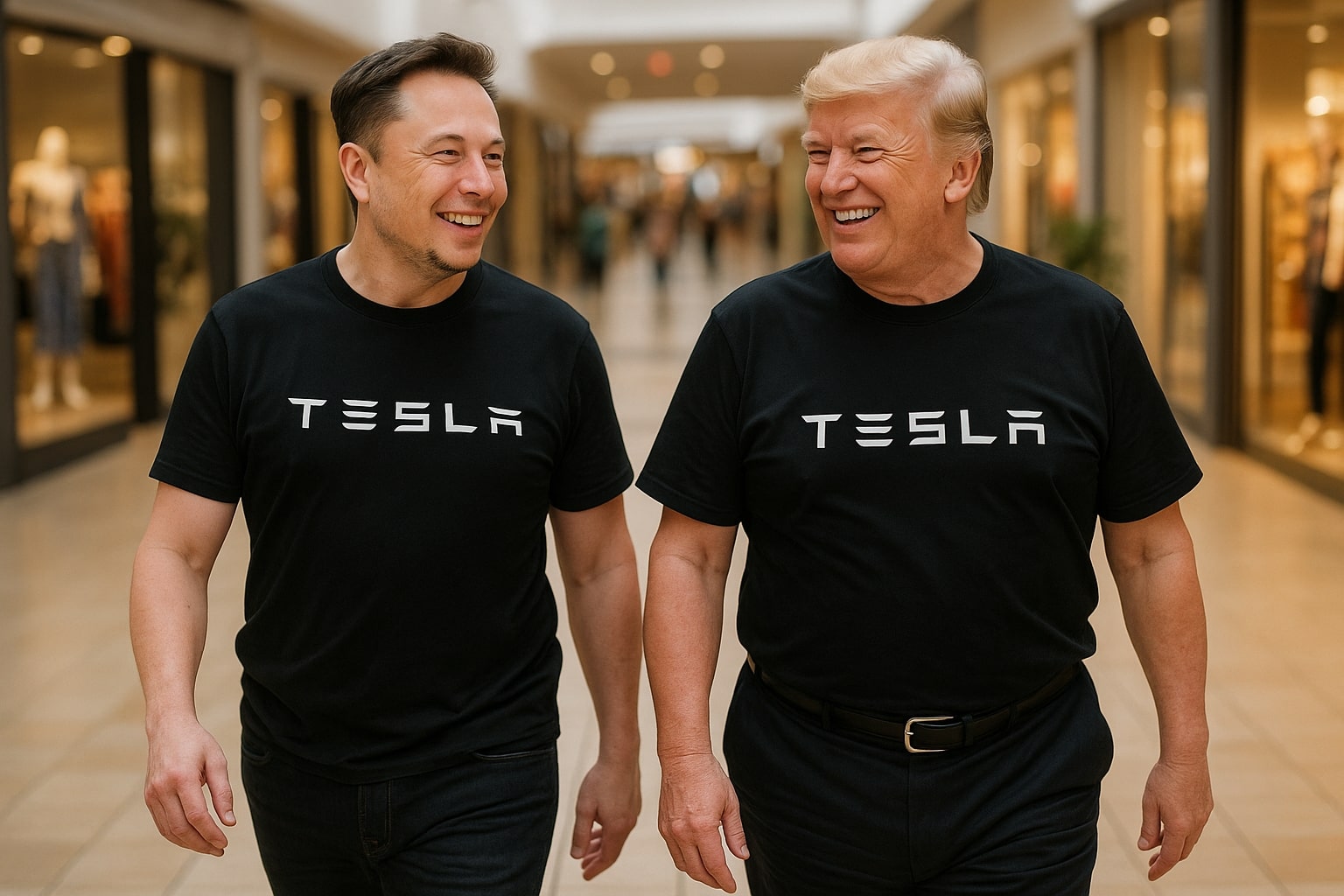
Is Tesla’s Stock Undervalued at $168.50? A Deep Dive into NASDAQ:TSLA’s Future
At $168.50, is NASDAQ:TSLA a hidden gem, or are the risks too high? Can Elon Musk’s strategy push TSLA past $350 in 2025? | That's TradingNEWS
Tesla’s Future: A Comprehensive Look at NASDAQ:TSLA Amidst Challenges and Opportunities
Analyzing NASDAQ:TSLA's Position in 2025: Market Conditions, Technical Indicators, and CEO’s Vision
Tesla, Inc. (NASDAQ:TSLA) has faced various headwinds in 2025, but recent market movements and company announcements suggest that despite declining Q1 earnings and other setbacks, the company may present a strong bullish opportunity for investors. On May 5, 2025, Tesla’s stock price was at $168.50, reflecting some of the challenges and changes in the EV market. However, despite a revenue dip and the competitive pressures from other electric vehicle (EV) manufacturers, there are compelling reasons to consider NASDAQ:TSLA as a potential buy.
Tesla's Q1 Earnings: The Highs and Lows
Tesla’s Q1 2025 performance has been a mixed bag. On one hand, the company reported revenue declines of 9% YoY to $19.34 billion, falling short of Wall Street’s expectations of $21.3 billion. Additionally, Tesla's net income dropped by a staggering 71% to $409 million, marking the company’s weakest quarterly performance since 2022. This comes as the company faced a 13% drop in vehicle deliveries, the lowest since mid-2022. The auto sector, in particular, saw a 20% drop in revenue to $14 billion, reflecting intense competition, especially from BYD (OTCPK:BYDDF) and other international EV players.
However, there are silver linings. Despite these declines, Tesla’s stock price surged over 4% following the earnings release, indicating that the market might have priced in these challenges. A significant part of the positive sentiment stems from CEO Elon Musk’s renewed focus on NASDAQ:TSLA, moving away from distractions like Dogecoin and placing more energy into driving innovation within Tesla.
Tesla's Energy Storage: A Key Growth Driver
Tesla’s energy storage segment has emerged as a bright spot in an otherwise challenging quarter. The company’s energy storage solutions, specifically Megapacks, have experienced rapid growth, and Tesla CEO Elon Musk emphasized the sector's potential, stating that they are aiming for "terawatts per year" in energy storage deployment. The growing demand for energy storage across global markets presents Tesla with an opportunity to diversify its revenue streams beyond traditional EV sales.
Affordable EV Models on the Horizon
Another major development in Tesla's future strategy is the anticipated release of more affordable EV models. As Musk stated in the earnings call, Tesla is planning to roll out new models in 2025 that will cater to a broader customer base. This could provide a significant boost to Tesla's vehicle delivery numbers, particularly in emerging markets where price sensitivity plays a crucial role in consumer decision-making.
Additionally, Tesla’s continued efforts to reduce its cost of goods sold (COGS) are expected to improve profitability in the coming quarters, despite margin contractions seen in Q1.
Improved Tariff Outlook: A Potential Tailwind for TSLA
The ongoing changes in tariff policies, particularly the easing of trade tensions between the U.S. and China, could serve as a tailwind for NASDAQ:TSLA. Tesla's diversified supply chains in North America, Europe, and China offer the company a level of insulation from tariffs. Musk's statement that Tesla is "the least affected car company" in terms of tariffs reinforces the idea that the company's global footprint provides it with a significant competitive edge. Moreover, Tesla’s compliance with U.S.-Mexico-Canada Agreement (USMCA) regulations ensures that many of its models, like the Model Y, are exempt from heavy tariffs.
Risks and Competition: The Growing EV Market and Brand Challenges
While Tesla has strong fundamentals, it faces numerous challenges, particularly in terms of competition. Traditional automakers are increasingly shifting their focus to electric vehicles, and the competition in the Chinese market is particularly intense. Brands like BYD are quickly catching up with Tesla’s offerings, and Tesla’s dominant position in the EV market could be threatened by new entrants and technological advancements from competitors.
Moreover, the future of government subsidies for EVs remains uncertain. A global recession or economic downturn could affect consumer spending power, further complicating Tesla’s path to sustainable growth. In addition, Tesla's over-reliance on Musk’s leadership and public image has led to controversy. His political statements and involvement in various ventures, including cryptocurrency, have hurt Tesla’s brand, and such actions continue to impact consumer sentiment and investor confidence.
Technical Outlook for TSLA: Bullish but with Caution
Looking at the technical indicators, NASDAQ:TSLA has shown some signs of strength, but there are also concerns. The recent rally into the 200-day Exponential Moving Average (EMA) suggests a potential breakout. However, the stock has struggled to maintain momentum above $170, with a slight sell-off indicating that there may be resistance in the $350 to $400 range in the short term.
The key technical levels for NASDAQ:TSLA include resistance at $350 and support at $150. A sustained move above $350 could set the stage for a move towards the $600 mark, potentially providing significant upside for investors. However, if the stock fails to break past these resistance levels, it may face further downside risks, especially if macroeconomic factors or competition in the EV market intensify.
Risks and Uncertainties: A Complicated Road Ahead for TSLA
As with any stock, NASDAQ:TSLA carries its risks. One of the biggest uncertainties surrounding Tesla is its ability to execute on its ambitious plans for full self-driving (FSD) vehicles and robotaxis. Although Musk has confirmed that Tesla plans to launch a fully autonomous robotaxi service in Austin by June 2025, the timeline for scaling this technology is unclear, and the regulatory landscape remains unpredictable. Rival companies like Alphabet’s Waymo are already ramping up their autonomous vehicle programs, and it remains to be seen whether Tesla can maintain its leadership in this space.
Moreover, Tesla’s valuation remains lofty, with the stock trading at a premium relative to its earnings. The high price-to-earnings (P/E) ratio and the company’s dependence on future technological developments for sustained growth make it a high-risk investment, especially if these ventures fail to materialize as expected.
Tesla's Brand and Leadership: The Musk Factor
The brand image of NASDAQ:TSLA has been significantly influenced by Elon Musk's personal actions and political statements. While some investors believe that Musk’s involvement in high-profile ventures, such as space exploration and cryptocurrency, adds value to Tesla’s broader vision, others argue that it detracts from the company’s core mission. The recent shift in focus away from Dogecoin (DOGE) and toward Tesla’s EV and energy solutions could help repair some of the brand’s image, but only time will tell whether this change is enough to maintain investor confidence in the long run.
Conclusion: Buy, Hold, or Sell?
Based on the current data and technical analysis, NASDAQ:TSLA shows signs of potential growth, but risks remain. Given the recent improvement in technical indicators and the promising developments in Tesla's energy storage and affordable EV models, NASDAQ:TSLA may still be a good opportunity for long-term investors. However, with high competition in the EV market and the ongoing leadership challenges under Musk’s management, it’s essential for investors to monitor the stock closely. At current levels, NASDAQ:TSLA may be a "Buy" for those confident in the long-term potential of Tesla’s vision, but those looking for lower-risk investments might want to approach with caution.
That's TradingNEWS
Read More
-
SMH ETF: NASDAQ:SMH Hovering at $350 With AI, NVDA and CHIPS Act Fueling the Next Move
16.12.2025 · TradingNEWS ArchiveStocks
-
XRP ETFs XRPI and XRPR: Can $1B Inflows Lift XRP-USD From $1.93 Back Toward $3.66?
16.12.2025 · TradingNEWS ArchiveCrypto
-
Natural Gas Price Forecast: NG=F Falls to $3.80–$3.94 as Warm Winter Kills $5.50 Spike
16.12.2025 · TradingNEWS ArchiveCommodities
-
USD/JPY Price Forecast - USDJPY=X Slides, BoJ 0.50% Hike, Fed Cut and NFP Set the Next Big Move
16.12.2025 · TradingNEWS ArchiveForex


















